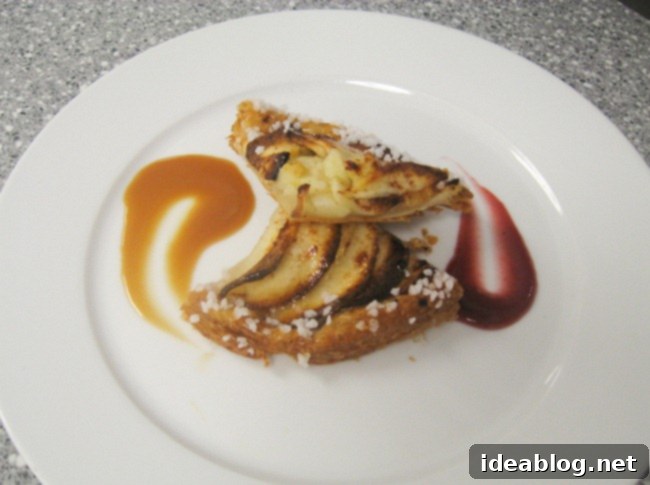A Day in the Life: The Intense Journey Through a Professional Culinary School
Embarking on a culinary school journey is far more than just learning to cook; it’s a rigorous immersion into the disciplined world of professional kitchens, demanding precision, endurance, and an unwavering passion for the culinary arts. Each day presents new challenges, complex techniques, and the constant pressure of perfection. Join me as I recount a typical day in my life at an elite culinary institution, from the earliest morning alarm to the final exam of the day.
The Unyielding Dawn: Starting the Day Right
5:30 AM: The insistent blare of my alarm shatters the stillness of the pre-dawn darkness. I allow myself a precious five-minute reprieve, hitting snooze while my cat’s distant meows remind me of the world already stirring. Finally, I push past the comfort of my bed, dress quickly, and set the kettle to boil for my essential morning coffee. Despite the early hour making the thought of food unappealing, I dutifully grab a simple breakfast – perhaps a banana, some yogurt, or another easily transportable item – knowing I’ll need the fuel later.
5:50 AM: With my knife bag slung over my shoulder, my bulky uniform bag in hand, and a fresh notebook tucked under my arm, I head out the door. The quiet of the morning commute is a small but welcome perk of this demanding schedule.
6:20 AM: One of the few undeniable advantages of waking up before most of the city is the absence of traffic. My 20-mile drive to school takes a mere 30 minutes, a blessing compared to rush hour congestion. Upon arrival, I quickly gather my gear from the car, make my way to the locker room, change into my chef’s whites, and stride towards the heart of the school: the kitchen.

Mise en Place Mastery: Preparing for the Culinary Day
6:35 AM: Although class officially begins an hour and a half later, the kitchen is already a hive of activity. My fellow early-risers and I immediately consult the daily ingredient list, heading to the commissary to gather everything needed for the day’s complex menu. It’s a precise operation: meticulously setting up our workstations, laying out our personal knife rolls, retrieving a utility bucket filled with essential equipment like ladles, spoons, and spatulas, and arranging cutting boards, various bowls, and deli cups.
My first major task often involves clarifying a pound of butter on the stovetop, a foundational technique for many classic French dishes, ensuring a pristine fat that won’t burn easily. We also retrieve our venison bones, which have been marinating for two days, drain them thoroughly, and begin the process of drying them out in preparation for searing during production. This critical step ensures maximum flavor extraction for our sauces later.
On this particular morning, I’m also tasked with preparing a substantial batch of vinaigrette in the high-powered Vitamix, a crucial component for the day’s salad, requiring perfect emulsification and seasoning.
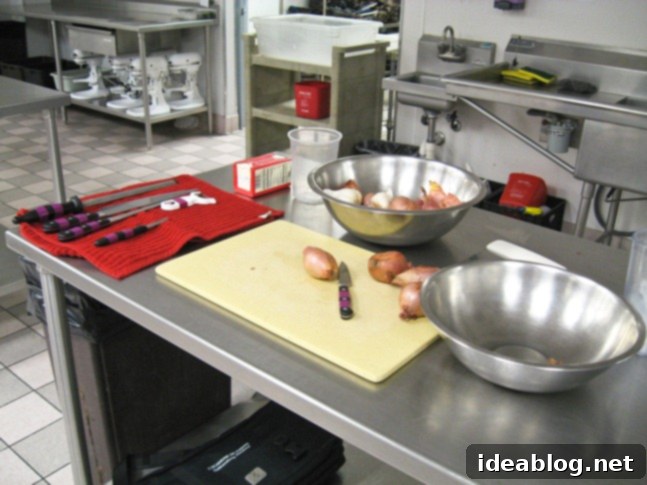
7:00 AM – 7:45 AM: The next critical phase is organizing Chef’s mise en place for the day’s demonstration. This involves a delicate dance of scaling out precise quantities for desserts, meticulously preparing mirepoix (the aromatic base of onions, carrots, and celery) and other key ingredients, and ensuring the classroom is fully stocked with all necessary equipment. A daily ritual for me is peeling and “de-germing” Chef’s head of garlic, along with a significant amount of shallots. My hands, inevitably, perpetually carry the pungent aroma of garlic – a true badge of a culinary student.
7:45 AM: With the demonstration prep complete, I quickly grab a fresh coffee, a bottle of water, and my notebook, then head into the classroom, ready for the day’s lesson.
Classroom & Culinary Concepts: Decoding the Day’s Menu
8:00 AM: As we settle into our seats, our eyes turn to the whiteboard, where the day’s intricate menu is elegantly displayed. We all begin diligently copying it into our notebooks, a precursor to the detailed note-taking that will follow. This menu, steeped in classic French culinary tradition, is both inspiring and intimidating:
L’OEUF DE CAILLE EN GELEE
LA SALADE EN COURONNE DE PAIN
LE MEDAILLON DE CHEVREUIL POELE
LA SAUCE GRAND VENEUR
LES TROIS PUREES
LA POMME DECOREE
LA TARTE CHAUDE AUX POMMES
Throughout the demonstration, our primary responsibility is to capture every detail, scribbling down notes and eventually typing up each recipe for our massive 5-inch binder, which serves as our cumulative coursework and is submitted for grading on exam days. A menu of this length would have utterly petrified me during Phase I, but now, it’s simply the challenging yet exciting norm.
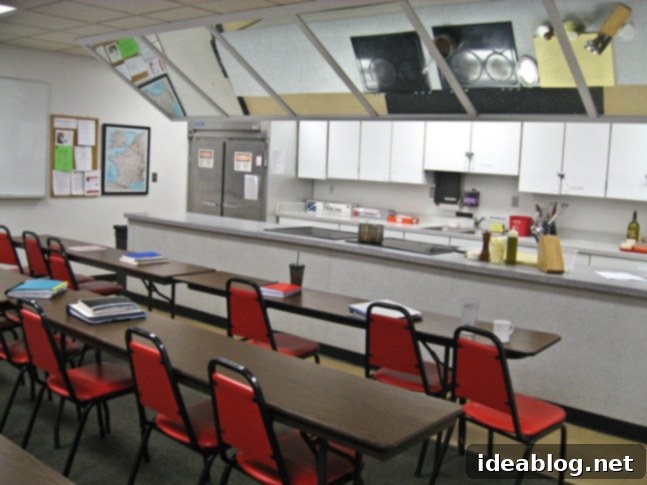
The Art of Demonstration: Learning from the Masters
8:00 AM – 10:30 AM: Chef Patrice, expertly assisted by Allyson and Chef Michel, conducts the day’s demonstration. With focused intensity, we watch every move, every cut, every technique, furiously scribbling notes into our notebooks. The complexity of each dish requires meticulous planning. I grab a piece of scrap paper to map out a vague strategy for organizing my time during the upcoming production phase, visualizing how I’ll tackle each “baby recipe” – our affectionate, yet slightly frustrated, term for dishes with multiple intricate components. These are often the most demanding to execute. I strive desperately to keep my brand-new notebook organized, knowing that clarity in notes translates to efficiency in the kitchen.
Today introduces us to two new, fascinating ingredients: venison tenderloin and aspic. Aspic, essentially consommé fortified with gelatin, forms a savory, meat-flavored jelly, a classic element in haute cuisine. It’s a delicate ingredient, requiring careful handling to achieve its signature clear, shimmering texture. This is accompanied by an exquisite salad featuring mache, endive, lola rosa lettuce, and arugula, all elegantly presented within a bread basket – a substantial, ring-shaped crouton – providing both visual appeal and a delightful textural contrast.
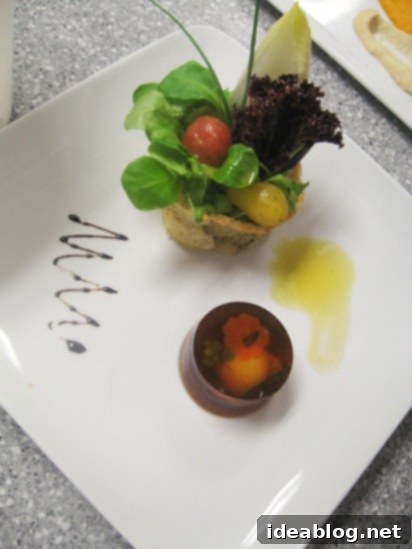
Production and Service Prep: The Race Against Time
10:50 AM: The demonstration concludes a little later than usual, pushing back our service time to 1:00 PM. Chef Patrice meticulously wraps up the day’s menu, plating each dish with artistic precision. We all rise to capture photographs of the stunning final plates and, more importantly, to taste everything. I’m particularly intrigued by our first course, the poached quail egg encased in aspic, adorned with a delicate “flower” fashioned from carrots, chervil, and chive “stems.” With only two hours until service, we quickly transition from spectators to chefs, heading back to the kitchen to begin our own intense production.
10:50 AM – 1:00 PM: The pre-service rush is often a blur of focused activity. My partner, Blanca, and I swiftly devise a system to divide the myriad tasks. We immediately tackle the main course’s complex Grand Veneur sauce—a classic currant jelly sauce traditionally served with game. This involves a multi-stage process, starting with searing the marinated venison bones to develop deep flavor, followed by a long, slow reduction in the oven. To prevent precious steam and flavor from escaping, the pot is meticulously sealed with a dough crust, a technique that speaks to the depth of classic French culinary arts.
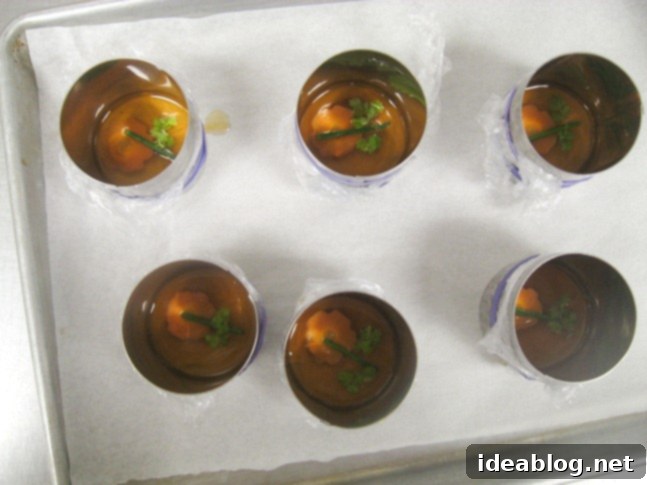
I also take on the challenge of the aspic dish. Luckily, the aspic itself is provided, but it needs to be carefully chilled to remain liquid without fully setting – a crucial balance. I begin the intricate process of assembling the molds, layering components and chilling them between each step to ensure perfect suspension and clarity. Simultaneously, I set a pot of water for poaching delicate quail eggs, carefully cracking each one into small cups with a paring knife, an act requiring utmost precision to keep the yolks intact.
The garnish for the aspic dish also demands attention. I create the “flower” by making channel cuts into a carrot, then slicing it incredibly thinly and blanching it to soften. Chives are cut into precise “stems,” and fresh chervil is meticulously arranged to act as the delicate “flower leaves.”
Concurrently, we begin rolling out puff pastry for our dessert and peeling a mountain of apples. The main course is accompanied by three distinct purees – chestnut, carrot, and celery root. To manage the workload and meet service deadlines, these are divided among the culinary teams. Our team is assigned the carrot puree, so Blanca and I promptly set about preparing it, starting the cooking process on the stovetop. The kitchen hums with controlled chaos, a testament to the collective effort required to bring a multi-course menu to life.
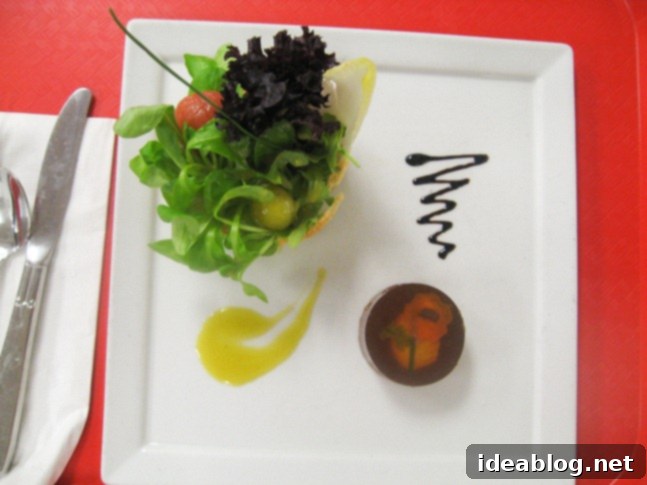
Service: The Ultimate Test of Skill and Speed
1:00 PM – 1:45 PM: In what feels like an instant, it’s time for service, and the kitchen erupts into a frenzied rush. We await Chef Patrice’s command to “fire” the venison tenderloin, ensuring it’s cooked to perfection, and to place the apple tarts in the oven so they emerge piping hot for our guests. Our team quickly begins plating our elegant first course, meticulously arranging them on trays, and delivering them to the front-of-house staff for our waiting guests.
Today, our team is serving four regular guests, plus an unexpected visitor who will be seated at our station during service. This means a rapid scramble to gather extra silverware, a stool, and to re-organize our already tight workstation. The pressure mounts further when we learn our table is serving Chef Francois, the esteemed director of the school. This adds an extra layer of intensity; presenting anything less than perfection means a direct visit from Chef Francois, who will not hesitate to provide constructive (and often intimidating) feedback.
After successfully delivering the first course, we swiftly return to the kitchen to begin plating and “firing” our second course. This involves carefully placing our desserts into the oven, precisely searing our venison steaks to the desired doneness, and applying the final, critical touches to our Grand Veneur sauce, ensuring its ideal consistency and flavor.
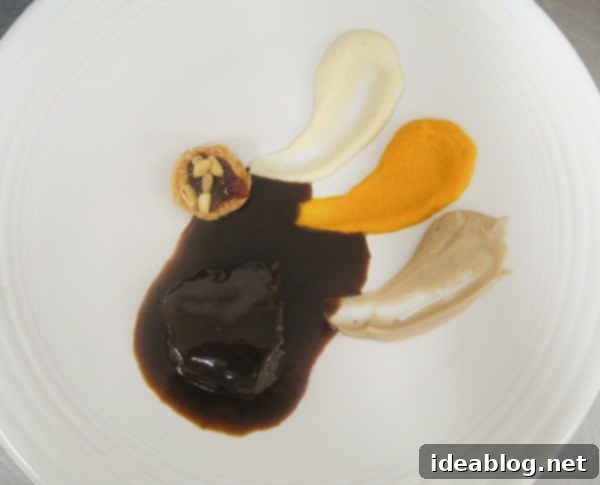
For the venison, we also assemble a unique garnish: small puff pastry cups, which we carefully made during production. Into these delicate cups, we pipe a savory-sweet mixture of red currant jelly and horseradish, finishing each with a sprinkle of toasted pine nuts for texture and nutty aroma.
Typically, the moment our main course leaves the kitchen, a wave of profound relief washes over me. The final push is to quickly plate the desserts, and then, mercifully, service is over. The silence that follows the service rush is a sweet reward.
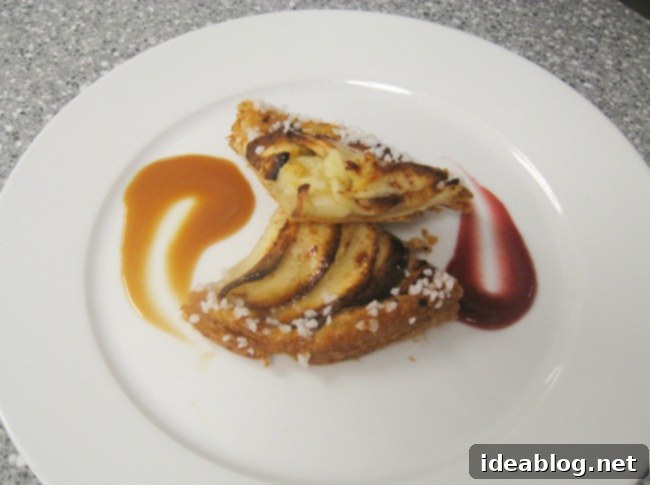
Post-Service Wind Down & Theory Exam
1:50 PM – 2:10 PM: Service complete, I finally allow myself a moment to breathe. I grab a plate and assemble a quick lunch from the leftover salad and any available venison – the exact fare varies day to day. More than food, however, I often crave water at this point, rehydrating after hours of intense heat and exertion. I also indulge in a piece of our delicious apple dessert, a well-earned treat. Joining my classmates, I head outside to the picnic tables behind the school, where we can relax, enjoy some fresh air, and decompress.
This brief respite often includes quizzing each other for our upcoming theory exam, a quick review session before the next mental challenge. Soon after, we head back inside to tackle the classroom cleanup, a process that typically spans 30 to 45 minutes of diligent effort. My team is responsible for the commissary, which means I quickly gather any leftover mise en place ingredients, return them to the walk-in refrigerator, and conduct a rapid inventory check.

I then return to the classroom to help with the final stages of cleanup: sweeping, mopping, and hauling out all the trash. It’s certainly not the most glamorous part of the day, but we’ve grown significantly more efficient at it since Phase I. Plus, there’s the added bonus of no longer having to trim endless chicken bones for stock – a small victory we all appreciate!
3:15 PM: Incredibly, it’s already 3:15 PM, and we are just sitting down to take our fifth theory exam. This challenging assessment typically consists of around 50 questions, along with practical costing exercises. Our scheduled 3:30 PM dismissal time is, predictably, not going to happen – a familiar norm in culinary school. Fortunately, the theory exam goes smoothly for me, and I manage to complete it within 20-25 minutes. I quickly head back to the locker room, ready to shed my uniform and mentally prepare for our upcoming fifth – and notoriously most difficult – practical exam. Each day is a relentless cycle of learning, doing, and proving our capabilities, pushing us closer to becoming professional chefs.
Practical Exam Update: Overcoming the Ultimate Challenge
Practical Exam Update:
The following Friday, we faced our fifth practical exam of the program. This particular exam is widely regarded as the most challenging of the entire curriculum, primarily because its extensive menu involves a multitude of complex dishes that are incredibly difficult to complete within the allotted time. We arrived bright and early at 7:45 AM, and the day’s demanding menu was promptly distributed.
Through sheer determination and relentless effort, I managed to finish just in time. The entire duration was a blur of high-speed activity, with two near-disasters that tested my composure. First, I accidentally burned a batch of caramel, forcing me to quickly restart for a crucial gastrique component. Second, I almost had a nasty fall on a slippery kitchen floor, a stark reminder of the constant vigilance required in a busy kitchen environment. Despite these heart-stopping moments, I am generally pleased with my performance, but above all, I felt an immense wave of relief to have successfully put this formidable challenge behind me. Each practical exam pushes our limits, refining our skills and hardening our resolve for the demanding world of professional culinary arts.
